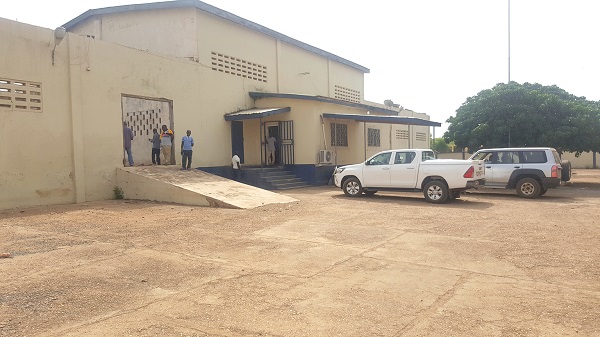
Govt turns to warehousing to reduce post-harvest losses
Eighty warehouses, each with a storage capacity of 1,000 tonnes are expected to be completed nationwide by the end of this year to help manage emergency food security, mop up excess produce from all farmers in order to reduce post-harvest losses (PHL) resulting from spoilage due to poor storage.
This is in addition to the existing 14 warehouses in eight regions with a total capacity of 33,000 tonnes, to protect farmers’ incomes and to facilitate the export of excess stock.
Advertisement
A breakdown shows the Ministry of Special Development Initiatives is responsible for 50 of the warehouses, currently awarded by the government while the Ministry of Food while Agriculture (MOFA) oversees the remaining 30.
The Chief Executive Officer (CEO) of the National Food Buffer Stock Company (NAFCO), under MOFA, Mr Hanan Abdul Wahab, disclosed this in an interview with the Daily Graphic.
He said NAFCO currently has a total of 1,381 licensed buyers and about 2,500 licensed suppliers, and said its intervention at reducing PHL, has not only created these direct jobs but has also contributed to growth in number of farmers and potential farmers, guaranteed farmers ready market and stabilised demand and supply of foodstuffs.
“As part of our role in preventing PHL, we purchase, sell, preserve and distribute food.
We mop up excess produce from all farmers, facilitate the export of surplus stock and expand the demand for food grown in the Ghana by selling to state institutions such as schools, prisons, hospitals, military.” Mr Wahab said.
PHL, are old age challenge to the agriculture sector in Ghana that threatens food and nutrition security.
PHL as measurable losses in edible food quantity or nutritional value (quality) of food intended for human consumption.
Simply put, food loss is food that is available for human consumption that goes unconsumed.

How serious?
An FAO commissioned study states that around one third (1.3 billion tonnes) of food produced for human consumption is lost or wasted globally each year, with losses in sub-Saharan Africa (SSA) higher than those in South and Southeast Asia.
Its estimates from 2011 suggest that as much as 37 per cent of food produced in SSA is lost between production and consumption.
For post-harvest handling and storage loss only, the FAO estimate is eight per cent, and the African PHL Information System (APHLIS) estimate is 10-12 per cent.
It is estimated that Ghana loses about GH¢700,000 annually on PHL. A World Bank report estimates that the value of PHL in SSA could reach nearly US$4 billion a year out of an estimated annual value of grain production of US$27 billion.
Some tomato farmers told this paper that some of their produce get rotten due to lack of storage facilities and ready buyers.
“I don’t have enough space to store tomatoes I grow if I don’t get buyers early.
So, I have for some years now stopped its production,” Madam Juliana Keele, at Ko in the Nandom Municipality in the West region said during a visit.
The PHL can occur throughout the value chain; from the time of harvest through processing, marketing, preparation, and finally consumption, and that in yam is said to be around 60 per cent high.
Data by the Food Research Institute under the Council for Scientific and Industrial Research (CSIR) shows that yam waste comes in various forms, as peeling losses can be 15-20 per cent high and which makes processing a marginal business proposition.

Mr Hanan Abdul Wahab, CEO of NAFCO
A yam trader at the Madina market in Accra, Madam Rita Narh, said she once lost her pile of yam stock due to heavy rains.
“I lost all my capital when the entire market was flooded about three years ago. Till date, I still owe some of my suppliers. It will be good if government can help by providing good storage facilities for us in the market as well, she said.
The main drivers
The extent and nature of PHL vary by crop. Data by the International Food Policy Research Institute (IFPRI), in 2018, cited major crops such as mango, tomato, cassava and yam as having the highest percentage of PHL.
It said mango recorded 45.6 per cent with tomato having 37.5 per cent, while cassava had 33.6 per cent and yam 31.4 per cent PHL. Other crops such as maize, rice and cowpea recorded 14, 13.5 and 10 per cent respectively.
In an interview, the General Secretary of the General Agricultural Workers Union (GAWU), Mr Edward Kareweh, said some major causes of PHL range from poor harvesting methods, poor handling procedures, poor drying techniques, usually recorded at the producer level and lack of storage facilities.
He said other causes include lack of marketing and distributing policies, lack of good road infrastructure and inadequate extension service delivery.
Some interventions
NAFCO was incorporated in March 2010 to among others, ensure food security and insulate farmers against losses resulting from anticipated increases in production.
After the collapse of the Ghana Food Distribution Corporation (GFDC), most of the excess foodstuffs Ghanaian farmers produced went waste.
NAFCO also has four packhouses in three regions.
The latest intervention to reduce PHL is the Ghana Commodity Exchange (GCX), an electronic platform for buyers and sellers of agricultural and other commodities to trade in efficient and orderly manner, under set rules, and regulated by the Securities and Exchange Commission (SEC).
Under the GCX, there is room that ensures access to market for the farmer and at the same time, because it is backed by warehouse receipt system (WRS), it provides storage for the farmer and ensure that goods stored there get the right quality and quantity for the farmers.
Again, a regulated Ghana Warehouse Receipt System (WRS) project initiative has been introduced and it is being implemented with the support of the International Finance Corporation (IFC)/ World Bank Group, with funding by the Swiss State Secretariat for Economic Affairs (SECO), as a financial inclusion programme to help farmers to be able to access credit and provide an avenue for them to market selected harvests.
It is expected that farmers can now postpone sales until when the market is more profitable, because, normally, they lack access to market information and are unable to absorb surplus produced during harvest.
This leads to a glut which results in low farm-gate prices and erode the income of poor households and smallholder farmers and expose them to food insecurity.
Recommendation
The Ghana Trade and Livelihoods Coalition (GTLC) has often advocated agricultural cooperative system (farmers with common interests often organise through cooperatives to strengthen their market power) as one of the best channels through which smallholder farmers can be mobilised and progressively impact enough capacity on them to overcome the challenge of PHL.
It said unless the farmers are well organised into groups, coupled with a department of cooperatives to consistently work with them in a manner that can reach small and larger groups at once, overcoming challenges with production will be difficult.
The Peasant Farmers Association of Ghana (PFAG) has said that smallholder farmers produce about 80 per cent of our food and so they need interventions to help reduce the effect of PHL.
Writer’s email; [email protected]




